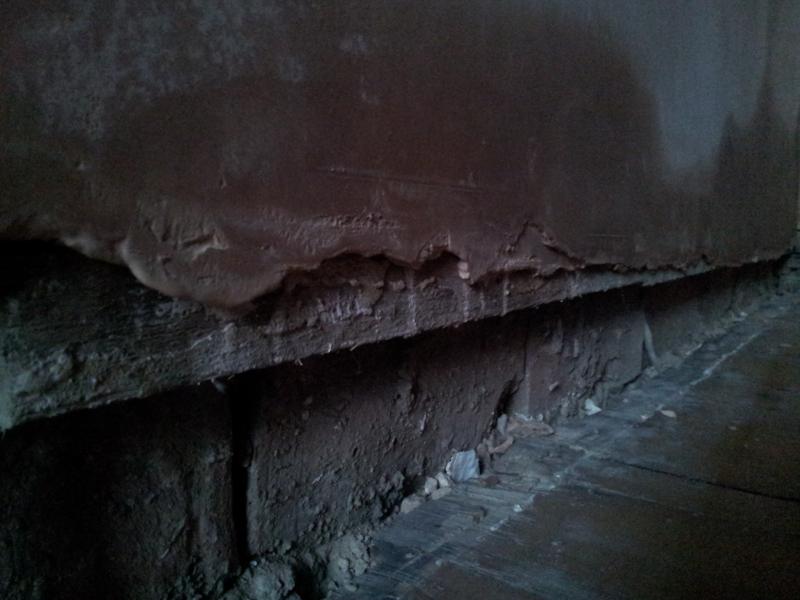What you really should have done was to fix the skirtings first and the plaster could have plastered to the new skirting line.
I'd have to totally disagree with you there. Plasterers will tend to make a right royal mess of the skirtings if you do that, a mixture of snots, water run-off (from the polishing) and possibly trowel marks (damage) on the timber not to mention possible swelling and/or warping of the timber leading to cracking at the joint between the skirting and the plaster at a later date when the timber dries out. Skirtings are ALWAYS fixed after the plasterer is finished and the plaster IF AT ALL POSSIBLE. The rule was, AND STILL IS, wet trades PRECEDE joinery 2nd fix and THE WALLS MUST BE ALLOWED TO DRY OUT
If I can simplify this the battens are not for fixing the skirting boards, they were originally put on so that the plasterers had a straight line to follow for the backing coat.
The skirtings were then fixed using the timber plugs at the same points where the battens were attached.
Then the final skim coat was applied.
In other words your fixing points are already there, to fix using any other method is just creating unnecessary work.
Which book did you read that in? As an apprentice we used to put in skirting grounds just like the one illustrated, fixed onto propellor wedges (which the apprentice used to cut with a hatchet) - although the grounds looked like a ladder and were made up in long sections in the workshop and delivered to site; I suspect that when the OP's skirtings were taken out the lower batten simply went with it, if it wasn't rotted away completely (common problem). The plasterers worked to the ground and ALWAYS did their finishing coat BEFORE we put in the skirtings. The affect of allowing lime plaster (or even gypsum) wash-off in a final coat to run off onto an unpolished oak skirting would be to FILL THE GRAIN WITH WHITE LIME - a disaster which would result in the skirtings being "pulled" by the polishers/varnishers. And prior to WWII it was ALL lime plaster. It still is on many (listed) renovations and some better quality houses
I think there wont be much guts left in wooden plugs that are probably over 100 years old and its unlikely anyone is going to use 3" cut nails to fix the skirting anyway
Quite right! Were I starting that job I'd have pulled out the remains of the original grounds and propellor wedges and filled the gaps with a strong compo mix. I'd then have replaced the grounds fixing with modern screws/brown plugs before letting the plasterer loose. I'd also have given the plasterer very specific instructions on how to finish to the grounds. This isn't news to decent, trained plasterers - some better quality construction firms have us joiners build plasterers frames in door and window openings from plywood so that the plaster reveals will be near perfect - absolutely essentialwhen installing architrave-less casings (especially the ones with plaster shadow gaps). This plasterer possibly didn't know what he was dealing with because grounds like those are rarely used these days
It may be the oldest method but it is still the best if you are fixing deep skirtings.
On the other hand if you are talking 75mm 100mm pencil round then I suppose you could get away with adhesive if you want a bodged job
I agree with you on the first point, but most certainly not on the second. The generally accepted (and the taught method for C&G) method of building is now to attach softwood or MDF skirtings with only a grip adhesive and pins - providing that the wall is in good order and dry the skirting will become permanently bonded to the plaster. I do enough refurb work to know how strong that bond can be - with 25 year old grip-adhesive mounted skirting often exhibiting excellent bonds. And in the last 25 years these adhesives have just got better and better.
In high traffic areas and areas with the chance of contact damages the practice is to use the above (glue/pin) in addition to drilling, plugging and screwing (with the screw heads sunk and filled with 2-pack unless the skirting is to be clear lacquered in which case pellets are used). Hardwood is invariably fixed with counterbored screws, plugs and pellets because it tends to be more prone to movement and is invariably clear lacquer coated
Then again I join my skirting boards together with a finger jointer on a router table and PVA adhesive to make long lengths.
My gaffer taught me to cut at about 30 degrees as opposed to the traditional 45. Makes the joint less obvious and is easier to level up. Modern mitre mate adhesives are remarkably strong and well worth trying as an alernative



